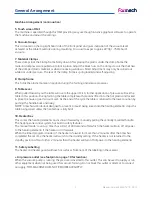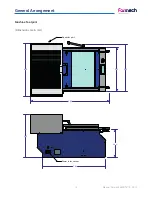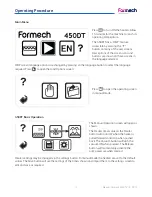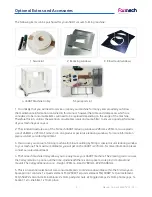
Manual - Formech 450DT V1.0 - 0317
23
Tooling
All tools should be mounted on a baseboard. They should not have undercuts and must be produced with
slightly angular sides (‘draft angle’) to aid release. Vent holes are needed to allow the air to be evacuated
from pockets and sharp angles on the tool. Providing these holes are kept small (1mm diameter or less) they
will not leave marks on the surface of the finished moulding.
Tools made from wood or medium density fibreboard (MDF) are easily constructed and can give short runs
of good quality mouldings at a low cost (see notes below). The use of close-grained wood will avoid grain
patterns appearing on the mouldings.
Plaster of Paris may be used for one-offs but the plaster must be allowed to properly dry out. (See notes
below)
Aluminium tools have the advantages of carrying fine detail and being more resistant to both distortion and
surface damage. Aluminium tools should be pre-heated before use. A cool metal mould will absorb some of
the heat from the plastic sheet before it can take up the full definition.
Resin tools combine most of the advantages of metal moulds with relative ease of manufacture. Various
resinous materials are commercially available especially for vacuum forming tool production.
Repairs to the vacuum circuit can be costly.
The use of talc as a release agent is not recommended.
It may clog the vacuum filter, valves and hoses.
MDF Baseboard
Aluminium Baseboard
NOTES:
Porous mould materials such as wood and plaster should be properly sealed to prevent the vacuum pump
from sucking out any moisture or sawdust, loose plaster etc. The vacuum circuit may quickly become blocked
with dust or slurry if moulds are not properly sealed.
As the plastic cools after forming it will contract, gripping the tool tightly. If the tool has been made with
sloping sides and has a good surface finish it will release more easily. Where the draft angle must be kept to
a minimum a release agent may be used to assist release.
Sealed moulds will usually release more easily. Silicone based release agents may be used on more difficult
moulds. Silicone based release agents are rapidly absorbed by porous (unsealed) moulds, rendering them
ineffective.
















































